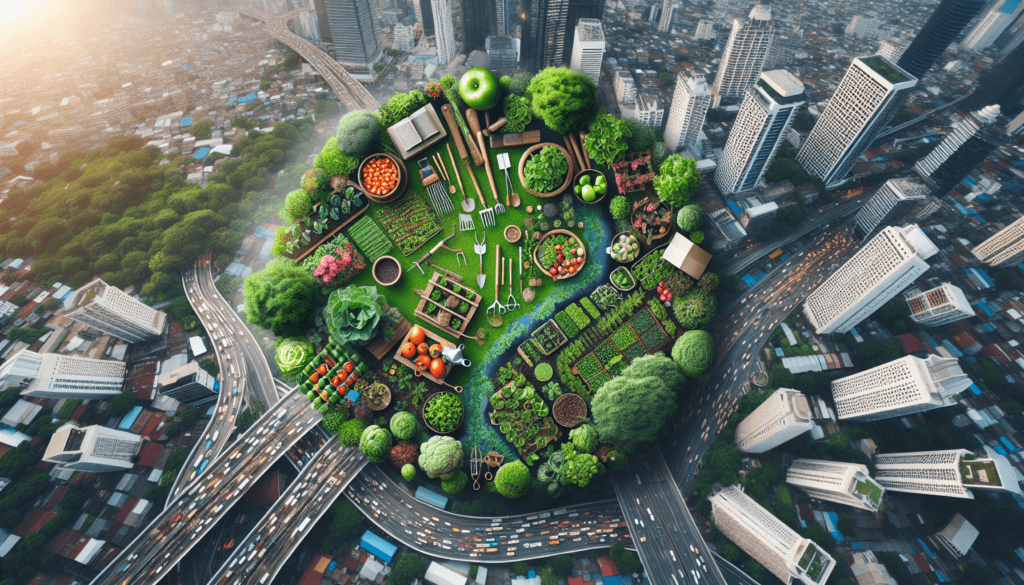Are you curious about the distinction between a community garden and an urban garden? Both may be flourishing green spaces, but they serve different purposes. A community garden is a collaborative endeavor where locals come together to cultivate vegetables, flowers, and other plants, promoting social interaction and community engagement. On the other hand, an urban garden is typically a small-scale oasis nestled within a city, providing a peaceful retreat for urban dwellers and often focusing on sustainable practices. Let’s further explore the unique characteristics of these two types of gardens and discover how they contribute to the collective well-being of their respective communities.

Location
Community Garden
A community garden is typically located in a residential area or a neighborhood setting. It is often found in a designated space within a community, such as a park or a vacant lot, where residents come together to grow plants and vegetables.
Urban Garden
On the other hand, an urban garden can be located in any urban setting, such as a rooftop, balcony, or even a small backyard. It is designed to make use of limited space within urban areas, where traditional gardening might be challenging.
Ownership
Community Garden
In a community garden, the ownership is usually shared among the community members who actively participate in its cultivation and maintenance. The garden may be collectively owned by the community as a whole or managed by a committee elected from within the community.
Urban Garden
In an urban garden, the ownership can vary. It could be owned by an individual or a group of individuals who have taken the initiative to utilize their urban space for gardening. In some cases, urban gardens may also be leased or rented from local authorities or private property owners.

Purpose
Community Garden
The primary purpose of a community garden is to foster a sense of community, encourage social interaction, and provide a shared space for neighbors to engage in gardening activities. It serves as a platform for community-building, skill-sharing, and promoting sustainable practices such as organic gardening.
Urban Garden
An urban garden, on the other hand, often serves multiple purposes. While it may also aim to bring communities together, its primary focus is often on maximizing the use of limited urban spaces for growing food, beautifying the surroundings, and promoting self-sufficiency. Urban gardens can also contribute to environmental sustainability by reducing food miles and improving air quality.
Size
Community Garden
Community gardens are typically larger in size compared to urban gardens. This is because they are often established in open spaces within neighborhoods or parks, allowing for larger plots and more extensive gardening areas. These larger spaces in community gardens also allow for a greater variety and quantity of crops to be grown.
Urban Garden
Due to the limited space available in urban areas, urban gardens tend to be smaller in size. They make creative use of vertical gardening, container gardening, or hydroponics to maximize the production within the limited space. Despite their smaller size, urban gardens can still yield significant amounts of fresh produce through strategic planning and efficient use of resources.

Management
Community Garden
The management of a community garden is typically a collaborative effort among the community members. It often involves a committee or a group of volunteers who take responsibility for overseeing the garden’s operations, allocating plots, organizing workdays, and coordinating community events. Decision-making within the garden is usually made through consensus.
Urban Garden
In an urban garden, the management is often more individualistic. The owner or a small group of individuals who initiated the garden take on the responsibility of managing the space, including planting, maintenance, and organizing activities. They may seek advice or guidance from horticultural experts but have greater autonomy in decision-making compared to community gardens.
Accessibility
Community Garden
Community gardens are typically open to all members of the community. They aim to be inclusive spaces, providing equal opportunities for individuals of diverse backgrounds and abilities to participate in gardening. The gardens may have designated accessible plots or raised beds to accommodate individuals with disabilities.
Urban Garden
The accessibility of urban gardens can vary depending on the location and the preferences of the garden owner. While some urban gardens may be open to the public, others may have restricted access due to safety concerns or the owner’s privacy. However, many urban gardeners actively encourage community involvement and organize workshops or open garden days to foster accessibility and knowledge-sharing.

Participants
Community Garden
Participants in community gardens typically include a diverse range of individuals, including residents from the immediate neighborhood, families, retirees, and individuals interested in sustainable gardening practices. These gardens often attract people who are passionate about gardening, building community connections, and promoting environmental stewardship.
Urban Garden
Urban gardens may have a similar mix of participants as community gardens, but they often draw a more eclectic crowd. Urban gardeners may include young professionals, urban dwellers living in apartments, and individuals seeking a self-sustainable lifestyle. Urban gardens tend to attract individuals who value fresh, locally grown produce and want to make the most of their limited urban space.
Design and Layout
Community Garden
Community gardens are often designed holistically, considering the overall layout and aesthetic appeal of the garden. They may include designated pathways, seating areas, communal gathering spaces, and even educational displays. The layout is usually planned to optimize gardening space while creating a welcoming environment for community members to interact and enjoy the garden.
Urban Garden
The design and layout of urban gardens are more focused on maximizing productivity within limited space. Vertical gardening techniques, such as trellises or green walls, are commonly used to optimize growing areas. Container gardening and raised beds are frequently employed to make the most of available soil or utilize alternative growing mediums like hydroponics or aquaponics systems. Urban gardens often prioritize functionality and efficiency above aesthetic considerations.

Focus
Community Garden
The main focus of a community garden is community-building and social cohesion. It serves as a meeting point for individuals from diverse backgrounds, fostering a sense of belonging and shared responsibility. Community gardens provide a platform for exchanging gardening knowledge, fostering intergenerational connections, and promoting sustainable practices within the neighborhood.
Urban Garden
While social interactions and community building are valued in urban gardens, their main focus lies in sustainable food production and self-sufficiency. Urban gardens aim to provide a local source of fresh produce, reduce reliance on long-distance transportation, and promote sustainable urban living. They often prioritize practicality and resource efficiency to maximize the yield of nutritious food within the confines of urban spaces.
Impact
Community Garden
Community gardens have a profound impact on individuals and communities. They promote physical and mental well-being by providing opportunities for outdoor exercise, stress relief, and connecting with nature. Community gardens also contribute to food security by providing access to fresh and affordable produce, especially in food-insecure neighborhoods. Additionally, these gardens have educational benefits, teaching individuals about gardening, sustainability, and environmental stewardship.
Urban Garden
Urban gardens have a significant impact on urban areas. They promote environmental sustainability by reducing carbon emissions associated with long-distance food transportation. By greening urban spaces, they also improve air quality and mitigate the urban heat island effect. Urban gardens can inspire and empower individuals to adopt more sustainable lifestyles and develop a sense of stewardship towards their immediate environment. Moreover, they can contribute to food security by providing fresh produce in areas where access to healthy food is limited.
In summary, both community gardens and urban gardens play important roles within their respective settings. While community gardens prioritize community-building and social interaction, urban gardens focus on sustainable food production and self-sufficiency in limited urban spaces. Despite their differences, both types of gardens have a positive impact on individuals, communities, and the environment, fostering connections, improving access to fresh produce, and promoting sustainable living practices. Whether you have access to a community garden or the opportunity to cultivate an urban garden, both can provide a fulfilling and rewarding experience. So, get your hands dirty and start gardening!


